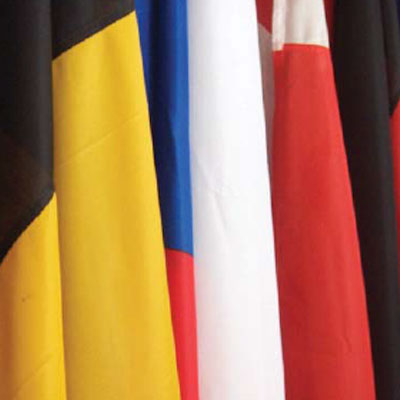The problems associated with migration with which Europe, Australia, and America are familiar are rapidly becoming problems for the highly industrialised nations of Asia and elsewhere.
Establishing legal frameworks are a vital step towards transparency in enforcing and appealing immigration policy decisions. The legal and policy framework for European migration illustrates how important it is for Christians concerned with migration to understand such frameworks. There is also a need for a more considered Biblical and theological response to cultural plurality that does not immediately wed itself to a particular multicultural policy. Cultural plurality is a social reality while multiculturalism explains a range of social and political theories that needs to be constantly critiqued from a Christian perspective.
1. European immigration policy in historical perspective
In 1557 there were more refugees in Geneva than Genevan-born inhabitants, and all 13 Calvinist pastors were non-Genevans. As a result, employment and housing shortages fuelled resentment towards these foreign migrants.[1] They were not easily integrated into the community, frequently forming their own language-based church congregations.
The Huguenots were French Protestants of the 17th century, who suffered terrible persecution under Louis XIV from 1685 onwards. An estimated 200,000 Huguenots immigrated to countries in non-Catholic Europe. Approximately 50,000 settled in England, introducing the word ‘refugee’ to the English language. English literature of the period warned of the threat the Huguenots posed to the employment market, public order and morality.
A historical perspective encourages us to remember that European migration is not something recent.[2]
2. Political frameworks
In Europe, 29 cities have a foreign-born population of over 100,000. London, Paris and Moscow have over 1 million. The ethnic diversity of large capital cities can readily lead to social conflict. In turn, this can influence the way in which journalists report on migration and the way in which politicians frame migration policies and laws. In its turn, this may lead to national governments developing immigration policy that is little more than an attempt to win votes from the electorate. For this reason, migration policy has fallen increasingly within the legal and policy competence of the European Union (EU).
In post-war Europe, political leaders planned for a Europe in which peoples would interact, trade, make friends, travel, relocate for work, marry across national borders, and learn to worship together. In today’s globalised Europe there can be few people who have no personal experience of migration or its effects.
3. Legal framework
a. Freedom of movement within the EU
In 1985 every EU citizen was granted the legal right to travel to, reside in, and take up employment in any of the EU member states. The policy approach of the EU towards internal migration is best described as ‘management’ rather than ‘control’ and in this respect the EU has gained considerable experience.
The EU’s immigration statistics include residents of EU countries who are entering or re-entering another EU country of which they are already a citizen. Current official EU estimates suggest that 71 million people in the EU are ‘foreign-born’. Of these, just over 40 million are citizens of an EU country who have migrated to another EU country. Just over 21 million are from Asia.
b. EU competency
The legal competency of the EU is established by two key treaties:
- the Treaty of Rome, signed in 1957; and
- the Maastricht Treaty signed in 1992.
These have been amended by a number of interim treaties, the most recent of which is the Lisbon Treaty, signed in 2007.
Within the legal framework of these treaties, important aspects of immigration policy have been gradually defined: the removal of internal border checks and the strengthening of external border controls (1985), migration and asylum policies (1999), and asylum regulations (2003).
Further legal instruments deal with the harmonisation of labour markets across Europe (2004),[3] of migrant integration (2005),[4] of asylum (2007),[5] and of border management (2008).[6] Since 2004, EU directives have also dealt with family reunification, the legal status of third-country nationals, migrant students, migrant researchers, victims of trafficking, and the admission of highly qualified third-county nationals.[7]
c. Harmonisation of migrant integration
In 2005 the EU adopted an immigration policy that addressed integration. The Common basic principles for immigrant integration policy in the European Union demonstrates a commitment to integration that avoids the French model of assimilation and the relativist multicultural models of the UK, Ireland, and the Netherlands. The EU’s focus on integration is now focused on more practical issues such as language learning. It ensures access to healthcare, social provisions, education, labour markets, as well as working towards active participation in civil and political processes.
4. Social consequences
a. The failure to integrate
In 2010 German Chancellor Angela Merkel announced the ‘failure of multiculturalism’. The premiers of France, the Netherlands and the United Kingdom all repeated her claim. Merkel had in mind the social conflict that was fuelled by the actual and potential growth of ethnic ghettos. While the issues of multiculturalism and immigration are not identical, there is a significant overlap. If there is a failure of multiculturalism, then the evidence suggests it is a failure of integration rather than a failure of welcome or tolerance.
The ways in which governments have developed political models of multiculturalism needs careful reflection. For example:
- Some have used it to allow ethnic communities to grow alongside each other and yet remain deeply divided by cultural and linguistic chasms.
- Others have decided that migrants should be encouraged to integrate but that they do this best when they do it using their own language and culture.
In practice, the countries of the EU are rapidly adopting pragmatic policies of civic integration which stress language-learning, a commitment to European values and identity, and developing a sense of national loyalty. As Christians we should promote plural diversity without having to promote multiculturalism. The first is a social reality; the second is a social theory. This distinction is important.
b. Integration and European cultural diversity
As Europe has been slowly constructing a new policy of interculturalism, there has been a simultaneous loss of confidence in multicultural and assimilationist approaches to the management of immigration. Interculturalism assumes the need for encounter, mutual understanding, integration, respect, co-existence and exchange.[8] It is apparent, however, that what constitutes the practice of intercultural dialogue is still far from clear. The EU attempted to provide a clear legal and procedural basis for social policy developments through the European Year of Intercultural Dialogue in 2008.
5. A missional response
a. Church practices that point to alternative European immigration policies
European Christianity is an intercultural form of Christianity. European theologians, missionaries, and church leaders have always had migrants among their ranks. Cultural or ethnic exclusivism is a denial of our common European Christian history.
Furthermore, an increasing concern for the welfare of migrants in Europe correlates with increased frequency of church attendance.[9] Active churchgoers are engaged in networking with migrant congregations, promoting social and cultural integration, and providing welfare and advocacy services for asylum seekers, refugees and trafficked migrants:
- Agencies such as Churches Against Sexual Trafficking in Europe (ChASTE) have adopted advocacy and mobilisation strategies in countries of origin and countries of destination for trafficked women.
- By 2010 over 180 migrant congregations were known to exist in Copenhagen. A Churches Integration Service (KIT) was established to meet the challenges, and similar agencies exist elsewhere in Europe.
- In 2010, the Churches Commission for Migrants in Europe declared a ‘Year of European Churches Responding to Migration’. It supported research into best practices in integration with its MIRACLE programme. It continues to lobby the EU for the right to permanent residency status for all migrants legally present in Europe after five years.
- In 2007, the French Protestant Federation urged ‘a new appreciation of migrant and ethnic minority Churches not as ethnic ghettos but rather as new centres of evangelization’.
Flexibility of response and lightweight structures are likely to remain central characteristics of migrant programmes for the foreseeable future in Europe.
b. De-secularising European immigration policies
In the biblical story of Ruth and Naomi, Ruth accepts the challenge of integration, ‘Your people will be my people and your God will be my God.’ (Ruth 1:16-18) and she is answered by Boaz, ‘May the Lord reward you for your deeds, the God of Israel, under whose wings you have come for refuge!’ (Ruth 2:11-13).
European immigration policy-makers frequently overlook the central place that religious convictions play in the life of migrants.[10] This is despite the fact that migrants are consistently more likely to be religious than are the citizens of their host countries.
6. Implications for global mission community
Policy developments in one part of the world are watched with interest in another. In practice, European migration policy and practice will probably continue to be driven by the impulse towards harmonisation and integration. The concern for practical aspects of integration — language acquisition, employment, inter-cultural dialogue, and social/civic integration — that is a feature of current EU practice can be expected to be taken up in other regions and countries of the world.
Many European churches and the migration agencies they may support are already developing their own mission responses including the teaching of indigenous languages to migrants. Others are running employment clinics. Others campaign for the social and civic integration of migrants. Several have opened up space for migrant leaders within their structures of governance and leadership.
Nevertheless, discrimination is not absent in churches and mission agencies. Paternalistic and colonial attitudes prevail in some church quarters. In this regard the global mission community has a gospel mandate to witness to the ultimate human experience of integration that is found in the offer of salvation, through which God calls together diverse people into the one common household of faith, without discrimination, favouritism or chauvinism.
Human sinfulness is clearly not the exclusive preserve of either the border guard or the immigrant. Each is capable of corruption; either one of them may manipulate circumstances or fabricate stories or evidence. However, it is imperative to remember that power and authority reside in the border and immigration officials. Churches have a biblical responsibility to advocate for the weak and the powerless ‘alien’.
The church community can offer an alternative space for the deep, non-coercive, mutual integration of migrants. In some countries, it is typically only within the church community that one finds inter-ethnic and inter-cultural friendships, relationships, and marriages.
Wherever churches around the world are working with migrants they will be meeting similar challenges to those faced by the churches of Europe. Employment, family, conflict, famine, or a call to mission may all play their part in furthering this constant movement. The reality that these factors are likely to persist will only place increasing demands on governments to develop transparent legal frameworks that more satisfactorily address migration. Churches and mission agencies must exercise constant vigilance in monitoring these relatively unheralded areas of the civic common good.
Endnotes
- T. H. L. Parker, John Calvin: A Biography (Oxford: Lion Publishing, 1975), p.169.
- For a fuller discussion of Europe’s history of migratory Christian theologians, missionaries and church leaders, see my ‘Imagine a Church Without Migrants!’ in Carroll, M. D. ed. Thinking Christianly about Immigration (Denver, CO: Denver Seminary, 2011).
- An EU approach to managing economic migration, 2004.
- Common basic principles for immigrant integration policy in the European Union, 2005.
- Future Common European Asylum System, 2007.
- A comprehensive vision for an integrated European border management system for the 21st century, 2008.
- Hailbronner, 2010, p4.
- See for example, the discussion here. Viewed 9th August 2010.
- See Jackson & Passarelli, 2007, p25.
- See Gina Bellofatto’s article entitled ‘People and Their Religions on the Move’ in the November 2012 issue of Lausanne Global Analysis.

